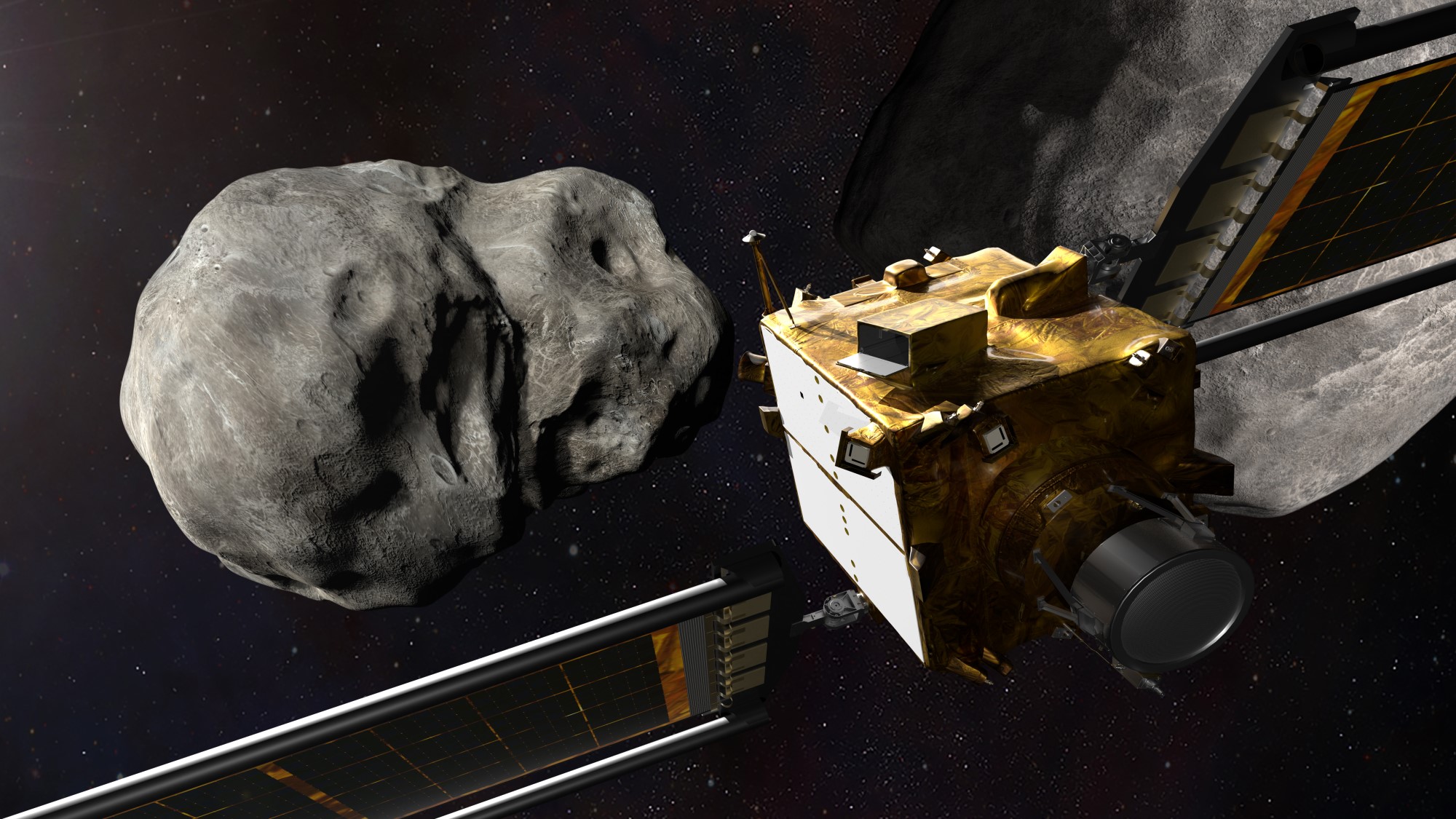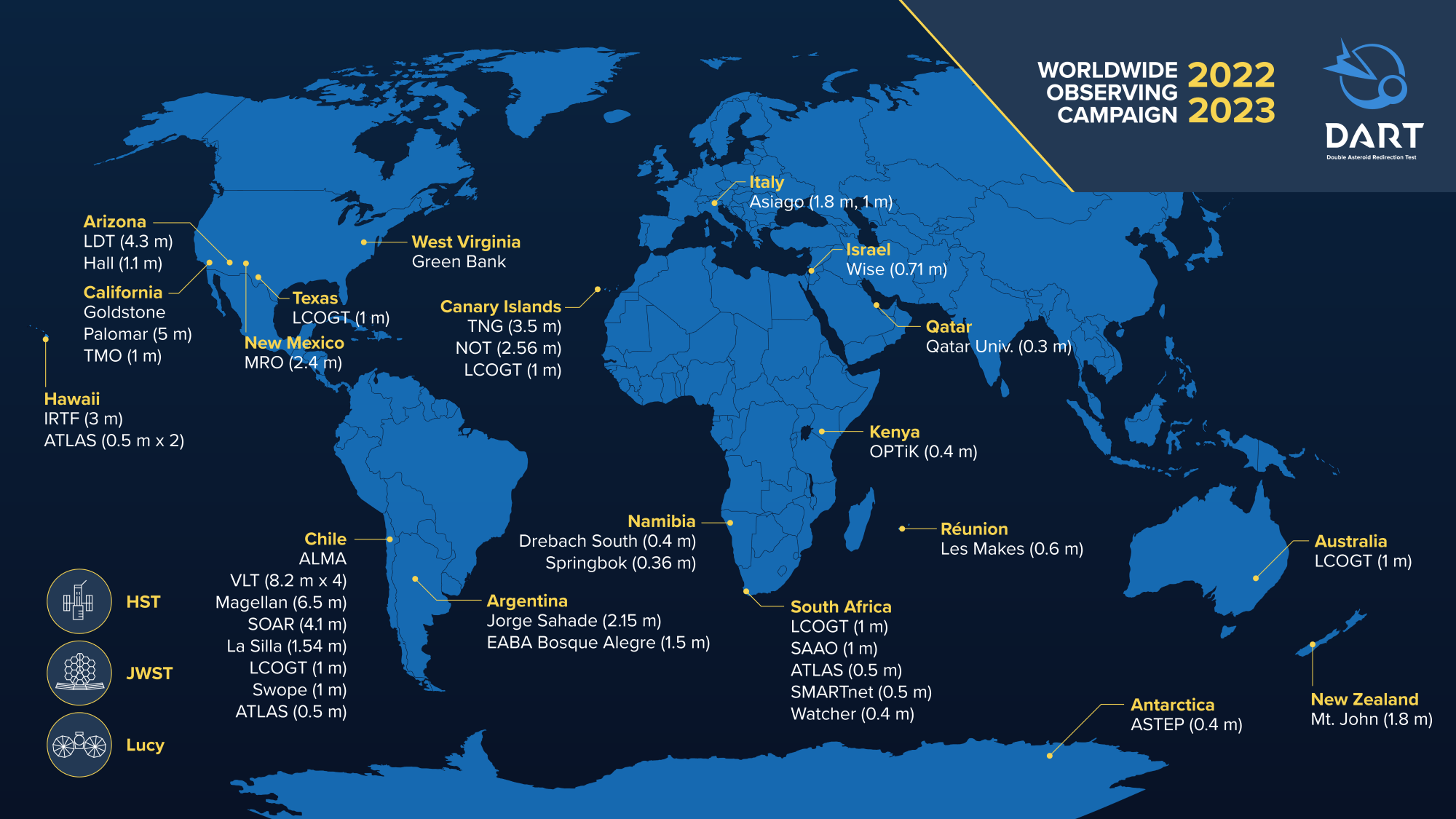Why ground-based telescopes are key to DART asteroid-smashing mission's success
DART's action-packed mission is a partnership involving instruments in space and on the ground.

For NASA's DART spacecraft, the drama happens in space — but mission success relies on telescopes back on Earth.
On Monday (Sept. 26), the Double Asteroid Redirection Test (DART) spacecraft will slam into a small space rock called Dimorphos — on purpose, at a staggering 4 miles (6.6 kilometers) per second. The exercise comes in the name of planetary defense, which aims to protect human civilization from any large asteroid that may be on a collision course. For the mission to succeed, scientists need to measure exactly how much the orbit of Dimorphos around its larger companion, Didymos, speeds up. And the DART spacecraft won't be in any shape to make that measurement itself, so mission personnel are relying on ground-based telescopes to track the aftermath of impact.
"There are very few missions where telescope observations are critical to understanding the success of the mission," Cristina Thomas, a planetary astronomer at Northern Arizona University who leads DART's working group for observations, told Space.com. DART is such a mission.
You can watch NASA's DART asteroid impact live online on Sept. 26, starting at 6 p.m. EDT (2200 GMT).
Related: What time will NASA's DART probe hit an asteroid on Sept. 26?
More: NASA's DART asteroid-impact mission explained in pictures
But the work began even before DART launched in November 2021.
Astronomers had detected Didymos in 1996 and its companion in 2003, but at the time, the rocks were just another binary asteroid. "Nobody really followed up on it rigorously because, you know, there wasn't a great need," Thomas said.
Breaking space news, the latest updates on rocket launches, skywatching events and more!
The observations DART is relying on began in earnest in 2015, Thomas said, before the DART mission had been formally approved but when discussions about it were well underway. After 12 years with no eyes on the Didymos system, these first intensive observations were crucial, Thomas said, letting scientists latch back on to the asteroids.
As the DART mission concept became a spacecraft, those observations continued. For DART, the most important result was precisely pinpointing how long it takes Dimorphos to orbit Didymos: 11 hours and 55 minutes.
That's become the baseline for the experiment DART will execute on Monday. DART must shave 73 seconds off that orbital period to be considered a success, although scientists think the effect may be more like 10 minutes. If a real asteroid threatened Earth and we hit it far enough in advance, the thinking goes, the effect will multiply enough that the asteroid crosses Earth's orbit when our planet is elsewhere.
But even after clocking Dimorphos' orbit, scientists kept watching the Didymos system. And they are truly watching the system as a whole, since Didymos and Dimorphos appear as a single spot of light to observers on Earth. Astronomers capture a series of photographs of that dot against a background of known stars to chart the system's changing brightness. Details of that pattern can differentiate between when Dimorphos passes in front of Didymos and vice versa, among other information.
"Unfortunately, it's a point source, it's just a very fast moving dot moving across the background of stars," Thomas said. "It might seem a little underwhelming, but to me, it's actually really a testament to how impressive our techniques have gotten, that we can take the information from this relatively small dot of light that's moving very quickly and pull so much information out of it."
As the impact has approached, more and more observatories have joined the work, Thomas said, noting that the DART team is already receiving data from telescopes on all seven continents. And because Didymos is so bright in the sky — the brightest it will be until the 2050s — those telescopes aren't all the massive research facilities you might think of.
"By doing it now, we really enable a much wider range of telescopes to be able to observe it," Thomas said. "We're going to get contributions from all around the world: from professional astronomers, amateur observers, I even have middle school students who are planning to observe this. It really kind of opens up this opportunity to the entire world to contribute and participate as well."
So observations are flooding in, Thomas said, and new telescopes are joining the campaign each day. Things are already busy as impact approaches, and they're only going to get busier. "It feels a little bit like controlled chaos," she said. "I think we're ultimately looking at a time period that's very, very busy, that's going to have a lot of information flying at all of us. But I think we've set ourselves up for success in the way that it's still going to be just fine."
Impact and beyond
Although scientists only need to measure how much Dimorphos' orbit speeds up in order to evaluate the mission's success, they'd sure like to see Monday's drama play out from a safe vantage point.
Catching the moment of impact itself will be tricky, however. "The impact will occur when Didymos is essentially over the Indian Ocean," Thomas said. "So there's not as many ground-based facilities observing as one might expect."
Nevertheless, the mission has recruited telescopes in South Africa, Kenya and Israel that might be able to see the impact. The James Webb and Hubble space telescopes, as well as NASA's Lucy asteroid mission, will also be observing before and after the impact for additional viewpoints. And a fleet of observatories stand ready to check in on the scene as soon as Didymos becomes visible at their location.
Even if the impact is successful, Didymos will remain just a dot to ground-based telescopes, but the dot will brighten as asteroid material blasted out by DART spreads farther into space and reflects sunlight. Tracking how the Didymos system first brightens and then fades over time, then, allows scientists to monitor the debris. (In addition, earlier this month, DART deployed a tiny spacecraft called LICIA Cube that will fly past the impact site three minutes later to photograph the wreckage.)
Those measurements should help scientists better understand the structure and composition of Dimorphos: think of throwing a tennis ball into a sand pit compared to bouncing it against asphalt. "I think it's going to be a really exciting time as we start to understand all of the clues in this big puzzle about what the properties of Dimorphos are," Thomas said.
Another characteristic scientists will be studying in post-impact observations is how Dimorphos spins as it circles Didymos, which is also a factor scientists are particularly focused on observing in the lead-up to impact, while Didymos is so bright. The spacecraft's dramatic arrival will change Dimorphos' rotation, so, as with the orbital period, baseline observations help DART personnel evaluate the effects of impact.
And the better scientists understand the DART impact, the more accurately they can extrapolate how this "kinetic impact" technique could play out in real life, should humans ever want to adjust the orbit of an asteroid that would otherwise hit Earth.
Thomas said she thinks that the DART mission's reliance on ground-based telescopes mirrors the way a real planetary defense mission would play out: with input from around the globe.
"I do really want people to understand that, especially when it comes to planetary defense, so much of this is connected; there's so many different parts of this puzzle," Thomas said. "It's not just the actions that we would take by testing out this kinetic impactor, but it's also about the resources we have here on the ground."
Those resources are why the moment DART falls silent — usually the most somber part of a mission — will, for once, be met with cheers.
Email Meghan Bartels at mbartels@space.com or follow her on Twitter @meghanbartels. Follow us on Twitter @Spacedotcom and on Facebook.

Meghan is a senior writer at Space.com and has more than five years' experience as a science journalist based in New York City. She joined Space.com in July 2018, with previous writing published in outlets including Newsweek and Audubon. Meghan earned an MA in science journalism from New York University and a BA in classics from Georgetown University, and in her free time she enjoys reading and visiting museums. Follow her on Twitter at @meghanbartels.

